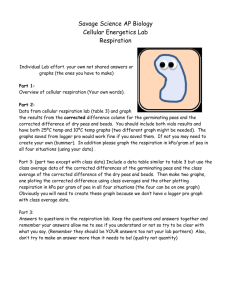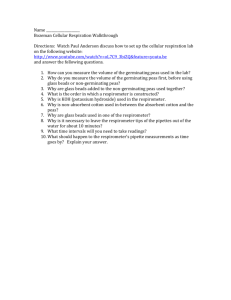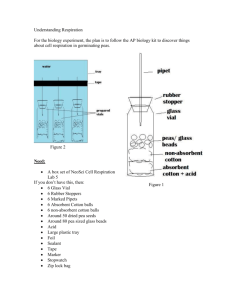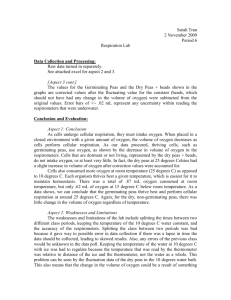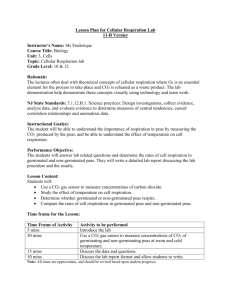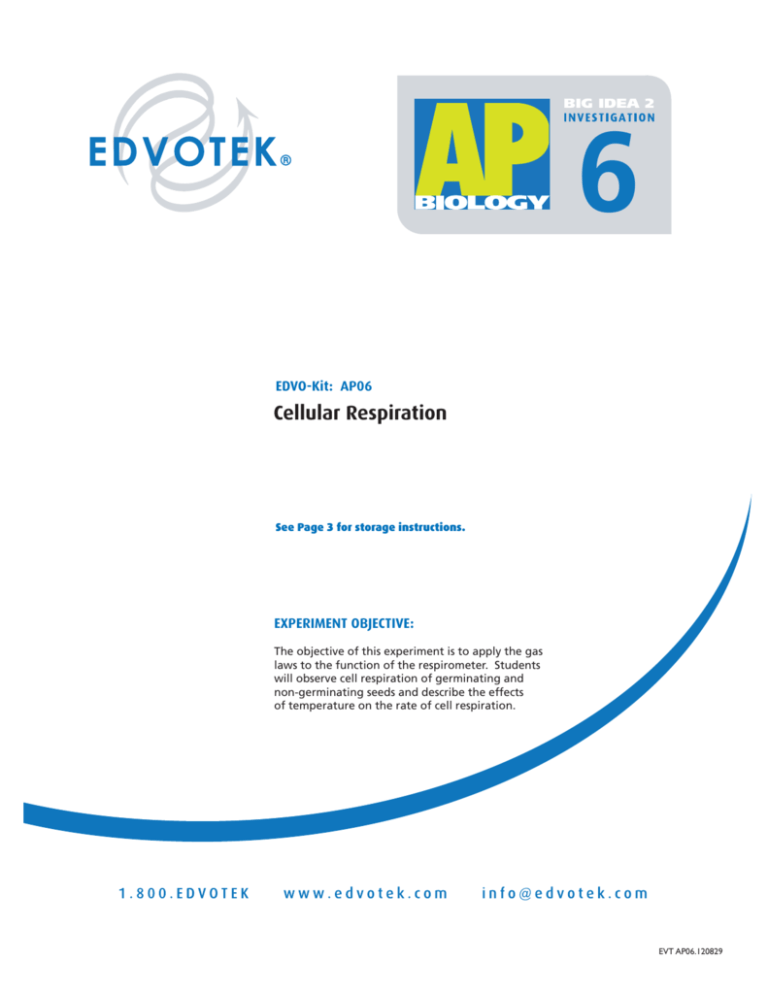
BIG IDEA 2
6
EDVO-Kit: AP06
Cellular Respiration
See Page 3 for storage instructions.
EXPERIMENT OBJECTIVE:
The objective of this experiment is to apply the gas
laws to the function of the respirometer. Students
will observe cell respiration of germinating and
non-germinating seeds and describe the effects
of temperature on the rate of cell respiration.
EVT AP06.120829
EX PERIMENT
AP06
Cellular Respiration
Table of Contents
Page
Experiment Components
Experiment Requirements
Background Information
3
3
4
Experiment Procedures
Experiment Overview
Taking Experimental Measurements
Experiment Results and Study Questions
Further Investigations
6
6
7
11
14
Instructor’s Guidelines
Notes to the Instructor
Pre-Lab Preparations
Experiment Results and Analysis
Study Questions and Answers
15
16
18
20
Material Safety Data Sheets
23
The Advanced Placement (AP) Program is a registered trademark of the College Entrance Examination Board. These
laboratory materials have been prepared by EDVOTEK, Inc. which bears sole responsibility for their contents.
All components are intended for educational research only. They are not to be used for diagnostic or drug purposes, nor administered to or consumed by humans or animals.
THIS EXPERIMENT DOES NOT CONTAIN HUMAN DNA. None of the experiment components are derived
from human sources.
EDVOTEK and The Biotechnology Education Company are registered trademarks of EDVOTEK, Inc.
The Biotechnology Education Company® • 1-800-EDVOTEK • www.edvotek.com
2
Duplication of any part of this document is permitted for non-profit educational purposes only.
Copyright © 1989-2012 EDVOTEK, Inc., all rights reserved. EVT AP06.120829
E XP E RIME N T
AP06
Cellular Respiration
Experiment Components
•
•
•
•
•
•
•
•
•
1 ml pipets
Glass beads
Peas
Potassium Hydroxide solution
Cork stoppers
Absorbent cotton
Nonabsorbent cotton
Plastic vials
Parafilm®
Store the entire
experiment at room
temperature.
This experiment is
designed for 10 lab
groups.
Requirements
•
•
•
•
•
•
•
•
Thermometers
Trays (at least 14” long)
Silicon glue
Ice
Cork borer
Tape
Timers
Metal washers
The Biotechnology Education Company® • 1-800-EDVOTEK • www.edvotek.com
Duplication of any part of this document is permitted for non-profit educational purposes only.
Copyright © 1989-2012 EDVOTEK, Inc., all rights reserved. EVT AP06.120829
3
EX PERIMENT
AP06
Cellular Respiration
Background Information
All life on earth ultimately depends upon the sun for energy. Photosynthesis in plants
traps energy from sun by formation of covalent bonds in complex organic compounds,
such as glucose. Organisms release this stored energy by the breakdown of glucose, using
a set of enzymatic reactions involving many steps. Breakdown of glucose can occur in
the presence of oxygen (aerobically), or in the absence of oxygen (anaerobically). Energy
released by the breakdown of glucose is stored in the high energy phosphate bonds of
adenosine triphosphate, ATP. Aerobic respiration yields the most energy for organisms,
with every mole of glucose producing about 36 - 40 moles of ATP. Under anaerobic conditions, only 2 moles of ATP are produced.
Cellular respiration is the breakdown of organic compounds, resulting in the release of
energy. The oxidative breakdown of glucose during cellular respiration produces the
energy needed for life in living organisms, as given in equation 1:
1.
C6 H12 O6 + 6 O2 → 6 CO2 + 6 H2O + 686 kCal/mol.
Carbon dioxide, CO2, a by-product of cellular respiration, is required for trapping the
energy of the sun by photosynthesis. Photosynthesis results in the formation of glucose,
oxygen, and water, as shown in equation 2:
2.
6 CO2 + 6 H2O + sunlight → C 6 H12 O6 + 6O2 + 6 H2O
The free energy content in the terminal phosphate bond of ATP is 7.3 kCal per mole of
ATP. Assuming the synthesis of 38 moles of ATP per mole of glucose broken down during
aerobic respiration, a total of 277.4 kCal of energy is stored in the high energy bonds of
ATP. This represents about 40.4% of the total free energy released during the breakdown
of one mole of glucose. The rest of the energy is lost as heat. Some of this is used to
maintain a constant body temperature.
This experiment is designed to measure oxygen consumed by either germinating or nongerminating pea seeds. To measure consumed oxygen, the ideal gas law (equation 3) will
be utilized:
3.
PV = nRT
P = the pressure of the gas
R = the gas constant (a fixed value)
V = the volume of the gas
T = the temperature of the gas
n = the number of molecules of the gas
In equation 3, R is always constant. If the pressure of the system (P), and the temperature of the system (T) remain constant, the volume occupied by the gas is directly proportional to the number of molecules of the gas.
The Biotechnology Education Company® • 1-800-EDVOTEK • www.edvotek.com
4
Duplication of any part of this document is permitted for non-profit educational purposes only.
Copyright © 1989-2012 EDVOTEK, Inc., all rights reserved. EVT AP06.120829
E XP E RIME N T
Cellular Respiration
AP06
Background Information
During this experiment, a respirometer will be used to measure the volume of oxygen,
and therefore the number of molecules of oxygen, consumed by the pea seeds during
cellular respiration. The CO2 released through respiration (see equation 1) is removed
from the system by potassium hydroxide (KOH), as shown in equation 4. Therefore, the
amount of CO2 gas released does not factor into the analysis and measurement of the
amount of oxygen consumed.
4.
CO2 + 2 KOH = K2 CO3 + H2O
The number of oxygen molecules consumed during respiration by the pea seeds will be
directly related to the decrease in volume occupied by gas within the respirometer. The
water in the pipet will move toward the region of lower pressure, which is created within
the respirometer due to oxygen consumption. This assumes constant volume and pressure of the system. The control vial containing the glass beads will be used to measure
any change in water volume due to alterations of temperature and pressure. The data
will be corrected to reflect these external influences on the respirometer.
The Biotechnology Education Company® • 1-800-EDVOTEK • www.edvotek.com
Duplication of any part of this document is permitted for non-profit educational purposes only.
Copyright © 1989-2012 EDVOTEK, Inc., all rights reserved. EVT AP06.120829
5
EX PERIMENT
AP06
Cellular Respiration
Experiment Overview and General Instructions
EXPERIMENT OBJECTIVE:
The objective of this experiment is to apply the gas laws to the function of the respirometer. Students will observe cell respiration of germinating and non-germinating seeds and
describe the effects of temperature on the rate of cell respiration.
LABORATORY SAFETY GUIDELINES
Experiment Procedure
1.
2.
3.
4.
5.
Wear gloves and goggles while working in the laboratory.
Exercise caution when working in the laboratory – you will
be using equipment that can be dangerous if used incorrectly.
DO NOT MOUTH PIPET REAGENTS - USE PIPET PUMPS.
Always wash hands thoroughly with soap and water after working in the laboratory.
If you are unsure of something, ASK YOUR INSTRUCTOR!
LABORATORY NOTEBOOKS
Scientists document everything that happens during an experiment,
including experimental conditions, thoughts and observations while
conducting the experiment, and, of course, any data collected. Today,
you will be documenting your experiment in a laboratory notebook or on a
separate worksheet.
Before Starting the Experiment:
•
•
Carefully read the introduction and the protocol. Use this information to form a
hypothesis for this experiment.
Predict the results of your experiment.
During the Experiment:
•
Record your observations.
After the Experiment:
•
•
Interpret the results – does your data support or contradict your hypothesis?
If you repeated this experiment, what would you change? Revise your hypothesis to
reflect this change.
MATERIALS FOR THE EXPERIMENT
Each student group should receive the following:
•
•
•
•
•
•
•
•
3 Cork/pipet assemblies
3 Vials
Absorbent cotton
KOH solution
Nonabsorbent cotton
100 ml graduated cylinder
25 non-germinated peas
Small weights to hold vials in water
•
•
•
•
•
•
•
•
Glass beads
Tape
Thermometer
25 germinated peas
Tray
Silicone glue
Timer
Parafilm®
The Biotechnology Education Company® • 1-800-EDVOTEK • www.edvotek.com
6
Duplication of any part of this document is permitted for non-profit educational purposes only.
Copyright © 1989-2012 EDVOTEK, Inc., all rights reserved. EVT AP06.120829
E XP E RIME N T
Cellular Respiration
AP06
Taking Experimental Measurements
1.
Set up an ice bath at 10° C and a room temperature bath (24° C) as assigned by the
instructor. This should be done prior to beginning the other steps in order to allow
enough time for the water baths to equilibrate to the required temperature. To
attain and keep the 10° C temperature, add ice.
2.
Label 6 vials (respirometers) A, B, C, D, E and F.
Place a circle of absorbent cotton (approximately the size of a nickel) into the
bottom of each vial.
•
Carefully soak with 1- 2 ml of 15% KOH solution, not allowing any KOH solution to touch the side walls of the vials.
•
Place a circle of nonabsorbent cotton into the vials directly on top of the KOH/
cotton circle in the vial. This will keep the KOH solution from touching peas
during the experiment.
Determine the volume of germinated peas.
•
Fill a 100 ml graduated cylinder with 50 ml of water.
•
Add 25 germinated peas to the cylinder and measure the increase in water
volume. The difference represents the volume of the peas.
Pea volume = __________ ml.
4.
5.
•
Place the peas on a paper towel. These germinated peas will be used in Vial A.
•
Repeat steps for Vial D.
Be sure that the
amounts of KOH
and cotton are
the same for each
vial.
Experiment Procedure
3.
•
Determine the volume of non-germinated peas.
•
Fill a 100 ml graduated cylinder with 50 ml water.
•
Add 25 non-germinating peas.
•
Add glass beads to raise the volume to equal that obtained with swollen germinated peas.
•
Remove the peas and beads. Place them on a paper towel. The non-germinated peas and beads will be used in respirometer B.
•
Repeat steps for Vial E.
Determine the volume of glass beads.
•
Fill the 100 ml graduated cylinder with 50 ml water.
•
Add glass beads to raise the volume so it equals the volume of germinating
peas as determined previously in Step 3.
•
Place glass beads on a paper towel, to be used in Vial C.
•
Repeat steps for Vial F.
The Biotechnology Education Company® • 1-800-EDVOTEK • www.edvotek.com
Duplication of any part of this document is permitted for non-profit educational purposes only.
Copyright © 1989-2012 EDVOTEK, Inc., all rights reserved. EVT AP06.120829
7
EX PERIMENT
AP06
Cellular Respiration
Experiment Procedure
Taking Experimental Measurements
6.
Place one set of germinating peas into Vial A. Insert the cork/pipet assembly into the
vial. Repeat with the second set of germinating peas for Vial D.
7.
Place one set of non-germinated peas + glass beads into Vial B. Insert the cork/pipet
assembly into the vial. Repeat with the second set of non-germinated peas + glass
beads for Vial E.
8.
Place one set of glass beads into Vial C. Insert the cork/pipet assembly into the vial.
Repeat with the second set of glass beads for Vial F.
9.
Absorbent Cotton
Nonabsorbent Cotton
Glass Beads
Weights
Peas
Sealant
Water Level
Pipet
40_
Wrap Parafilm® or plastic wrap tightly
around the seams (cork and tube) to
seal any potential leak.
10. Make sure the ice water bath has
equilibrated to 10° C. Record the
temperature of the room temperature
bath.
11. Place a piece of masking or lab tape
over the water bath to suspend pipet
tips out of the water during the
equilibration phase.
12. Place Vials A, B & C into the 10° C
water bath and Vials D, E & F into the
24° C waterbath. Place them with the
calibrated side of the pipet facing up
to allow measurements to be taken.
35_
30_
25_
13. Allow the respirometers to equilibrate
in the water baths for 8 minutes.
20_
15
14. After the equilibration phase, immediately submerge each respirometer.
Water in the water bath will enter
the pipets and travel a short distance.
As respiration occurs inside the vials,
oxygen is consumed and the pressure
drops. Over time, as pressure drops,
additional water from the water bath
enters the pipets. Make sure the vials do
not fill up with water. If it does, there is
a leak which must be corrected. Reassemble the faulty respirometer.
The Biotechnology Education Company® • 1-800-EDVOTEK • www.edvotek.com
8
Duplication of any part of this document is permitted for non-profit educational purposes only.
Copyright © 1989-2012 EDVOTEK, Inc., all rights reserved. EVT AP06.120829
E XP E RIME N T
AP06
Cellular Respiration
Taking Experimental Measurements
15. Arrange the vials so you can read the volume markings on each
pipet. Place lead donuts or other weighted objects on the vials to
keep vials submerged.
16. Record the starting temperature. Maintain temperature by adding
ice or water as necessary during the experiment.
17. Record the starting point (“Time 0”) volume of each pipet. Take
readings of the volume of water in each pipet every 5 minutes for 20
minutes. Record these values in the tables on the following page.
19. Correct volumes measured for changes in environmental variables.
•
Vial C (and F) measures volume changes due to environmental
variables. For Vial C, the environmental effects are calculated
by subtracting the volume at given time (Tx) from the starting
volume at starting time (T0). This can be written as:
Vial C volume at Tx - Vial C volume at T0.
•
Use these
markings
(on the left.)
Environmental effects must be applied to data collected for vial
A (and D) as shown below:
Experiment Procedure
18. Collect class data for Vials A, B, C, D, E and F for both temperature
water baths.
When reading the
pipets, use the
inverse markings on
the pipet (i.e. starting
with 0.1 ml rather
than 0.9 ml) at the
pipet tip.
[ Vial A volume at Tx - Vial A volume at T0] [ Vial C volume at Tx - Vial C volume at T0]
•
Environmental effects must be applied to data collected for vial
B (and E) as shown below:
[ Vial B volume at Tx - Vial B volume at T0] [ Vial C volume at Tx - Vial C volume at T0].
The Biotechnology Education Company® • 1-800-EDVOTEK • www.edvotek.com
Duplication of any part of this document is permitted for non-profit educational purposes only.
Copyright © 1989-2012 EDVOTEK, Inc., all rights reserved. EVT AP06.120829
9
EX PERIMENT
AP06
Cellular Respiration
Taking Experimental Measurements
MEASUREMENT OF OXYGEN CONSUMPTION BY GERMINATING
AND DRY PEAS AT TWO TEMPERATURES
Reading at 24°C (Room Temperature)
Time X
Experiment Procedure
Minutes
"F" Beads Only
Reading
at Time X
"D" Germinating Peas
Difference*
Reading
at Time X
Difference*
Corrected
Difference**
"E" Dry Peas with Beads
Reading
at Time X
Difference*
Corrected
Difference**
0
5
10
15
20
Reading at 10°C
Time X
Minutes
"C" Beads Only
Reading
at Time X
"A" Germinating Peas
Difference*
Reading
at Time X
Difference*
Corrected
Difference**
"B" Dry Peas with Beads
Reading
at Time X
Difference*
Corrected
Difference**
0
5
10
15
20
* Difference = (Initial reading at 0 minutes) - (Reading at measured time)
** Corrected Difference =
(Initial PEAS Reading at 0 minutes - Initial PEAS Reading at X minutes) (Initial BEAD Reading at 0 minutes - Initial BEAD Reading at X minutes)
The Biotechnology Education Company® • 1-800-EDVOTEK • www.edvotek.com
10
Duplication of any part of this document is permitted for non-profit educational purposes only.
Copyright © 1989-2012 EDVOTEK, Inc., all rights reserved. EVT AP06.120829
E XP E RIME N T
AP06
Cellular Respiration
Experiment Results and Study Questions
Answer the following study questions in your laboratory notebook or on a separate
worksheet.
Graph your corrected data (difference) for Vials A, B, C, D, E, and F. Place time (in
minutes) on the x-axis and volume (ml O2 consumed) on the y-axis. Data from both
temperatures should be plotted on the same graph. Draw the best straight line
through the data points.
2.
What accounts for the difference in oxygen consumption seen between the germinating and non-germinating seeds?
3.
List some of the constant controls in this experiment.
4.
Why do the glass beads seem to be using oxygen?
5.
Why are the readings corrected using the glass bead values?
6.
What is the function of KOH in this experiment?
7.
From the slope of the lines, determine the rate of oxygen consumption at 10° C and
room temperature for the germinating and non-germinating pea seeds. Determine
the slope of the lines over a middle section of each line by dividing the difference in
volume reading by the difference in time. Volume (ml O2 consumed) values are determined from the line.
Experimental
Conditions
Calculations
Experiment Procedure
1.
Rate in
ml O 2 /minute
Dry Peas/ 10°C
Dry Peas/ 24°C
Germinated Peas/ 10°C
Germinated Peas/ 24°C
The Biotechnology Education Company® • 1-800-EDVOTEK • www.edvotek.com
Duplication of any part of this document is permitted for non-profit educational purposes only.
Copyright © 1989-2012 EDVOTEK, Inc., all rights reserved. EVT AP06.120829
11
EX PERIMENT
AP06
Cellular Respiration
Experiment Results and Study Questions
8.
Compare the rate of oxygen consumption at 10° C and room temperature. Why are
they different?
9.
How do you think the rates of respiration would change in peas that have been germinating for 0, 24, 48, 72, and 96 hours. Why?
Experiment Procedure
10. Write a hypothesis using the same experimental design to compare the rates of respiration in a mouse at both room temperature 24° C and at 10° C.
11. Using the same experimental design, write a hypothesis to test the respiration rate
of a 15 g reptile and a 15 g mammal at 10° C.
12. What basic cellular process is responsible for the oxygen consumption?
The Biotechnology Education Company® • 1-800-EDVOTEK • www.edvotek.com
12
Duplication of any part of this document is permitted for non-profit educational purposes only.
Copyright © 1989-2012 EDVOTEK, Inc., all rights reserved. EVT AP06.120829
E XP E RIME N T
AP06
Cellular Respiration
Experiment Results and Study Questions
Graph the results from the Corrected Difference column for the germinated peas and dry peas at both
room temperature and at 10° C. Label the horizontal x-axis "Time in Minutes.” Label the vertical y-axis
"ml O2 Consumed.”
Title: ______________________________________________________
Experiment Procedure
What is the independent variable? ______________________________________________________________
What is the dependent variable?
______________________________________________________________
What two hypotheses are being tested in this experiment?
_________________________________________________________________________________________________
_________________________________________________________________________________________________
The Biotechnology Education Company® • 1-800-EDVOTEK • www.edvotek.com
Duplication of any part of this document is permitted for non-profit educational purposes only.
Copyright © 1989-2012 EDVOTEK, Inc., all rights reserved. EVT AP06.120829
13
EX PERIMENT
AP06
Cellular Respiration
Further Investigations
1.
Design an experiment(s) to test the respiration rate of a reptile and a mammal of
similar weights at two different temperatures.
2.
Weigh the peas and find the average oxygen consumed/gram. Divide the milliliter
oxygen/hour by the weight in grams.
The Biotechnology Education Company® • 1-800-EDVOTEK • www.edvotek.com
14
Duplication of any part of this document is permitted for non-profit educational purposes only.
Copyright © 1989-2012 EDVOTEK, Inc., all rights reserved. EVT AP06.120829
E XP E RIME N T
AP06
Cellular Respiration
Instructor’s
Guide
Notes to the Instructor & Pre-Lab Preparations
Overview of Laboratory Investigations
The “hands-on” laboratory experience is a very important component of
science courses. Laboratory experiment activities allow students to identify assumptions, use critical and logical thinking, and consider alternative explanations, as well as help apply themes and concepts to biological
processes.
Order
Online
EDVOTEK experiments have been designed to provide students the opportunity to learn very important concepts and techniques used by scientists in
Visit our web site for information
laboratories conducting biotechnology research. Some of the experimental
procedures may have been modified or adapted to minimize equipment
about EDVOTEK's complete line
requirements and to emphasize safety in the classroom, but do not comof experiments for biotechnology
promise the educational experience for the student. The experiments have
and biology education.
been tested repeatedly to maximize a successful transition from the laboratory to the classroom setting. Furthermore, the experiments allow teachers
and students the flexibility to further modify and
adapt procedures for laboratory extensions or
alternative inquiry-based investigations.
Technical Service
Department
Organizing and Implementing the
C H S E RV I C E
-TE
ED
VO
Mon - Fri
9:00 am to 6:00 pm ET
1-800-EDVOTEK
ET
(1-800-338-6835)
Mo
FAX: 202.370.1501
web: www.edvotek.com
email: info@edvotek.com
m
6p
n - Fri 9 am Please have the following
information ready:
• Experiment number and title
• Kit lot number on box or tube
• Literature version number
Experiment
Class size, length of laboratory sessions, and availability of equipment are factors which must be
considered in the planning and the implementation of this experiment with your students. These
guidelines can be adapted to fit your specific set
of circumstances.
If you do not find the answers to your questions
in this section, a variety of resources are continuously being added to the EDVOTEK web site.
www.edvotek.com
(in lower right corner)
• Approximate purchase date
In addition, Technical Service is available from
9:00 am to 6:00 pm, Eastern time zone. Call for
help from our knowledgeable technical staff at
1-800-EDVOTEK (1-800-338- 6835).
Visit the EDVOTEK web site often
for updated information.
The Biotechnology Education Company® • 1-800-EDVOTEK • www.edvotek.com
Duplication of any part of this document is permitted for non-profit educational purposes only.
Copyright © 1989-2012 EDVOTEK, Inc., all rights reserved. EVT AP06.120829
15
EX PERIMENT
AP06
Cellular Respiration
In s truct or ’s
Guide
Pre-Lab Preparations
If time does not permit each lab group to perform tests at both temperatures, assign half
of the lab groups to perform the 10° C experiment and the other half to perform the
room temperature experiment.
1.
Instructor’s Guide
2.
3.
4.
To germinate peas:
•
Two days before lab, place 25 seeds/group into a dish and cover with distilled
water overnight.
•
The following day, place swollen pea seeds into a moist paper towel and place
the towel into a paper bag stored in a drawer overnight.
To assemble respirometers:
•
Insert the pipets into the cork. The non-tapered end of the pipet should not
extend more than 5 mm beyond the smaller end of the cork.
•
Seal around the hole with silicon glue. After students add peas and/or glass
beads, have them wrap Parafilm® around the seams (cork and tube, pipet and
cork) to seal any potential leaks. Each group requires cork/pipet assemblies.
The day before the lab:
•
Fill 5 trays or pans with water at room temperature.
•
Determine the necessary volume based on the size of trays you have available for
water baths.
On the lab day, set up a pipetting station for the KOH solution.
Each student group should receive the following for
each temperature setting:
•
•
•
•
•
•
•
•
3 Cork/pipet assemblies
3 Vials
Absorbent cotton
KOH solution
Nonabsorbent cotton
100 ml graduated cylinder
25 non-germinated peas
Small weights to hold vials in water
•
•
•
•
•
•
•
•
Glass beads
Tape
Thermometer
25 germinated peas
Tray
Silicone glue
Timer
Parafilm®
The Biotechnology Education Company® • 1-800-EDVOTEK • www.edvotek.com
16
Duplication of any part of this document is permitted for non-profit educational purposes only.
Copyright © 1989-2012 EDVOTEK, Inc., all rights reserved. EVT AP06.120829
E XP E RIME N T
Cellular Respiration
AP06
Inst r uct or ’s
G uide
Pre-Lab Preparations
AVOIDING COMMON PITFALLS
Assemble respirometers ahead of time to ensure that the silicone glue will dry.
2.
Make sure the trays are large enough to contain the assembled respirometers (at
least 14" long). A large oblong glass casserole dish (27cm W x 38cm L x 6.5cm D)
works well if plastic trays are not available.
3.
You can cut the cotton circles for the vials ahead of time or the students can perform
this step.
4.
Have the students wrap Parafilm® or plastic wrap around the seams of the assembled
respirometers (around the seam of the cork and vial and at the area where the pipet
enters the cork). This is very important, otherwise the respirometers will leak and
the experiment will not work.
5.
Depending on the size of the students groups, they may want to each be responsible
for taking readings on one respirometer (each group has 3).
Instructor’s Guide
1.
The Biotechnology Education Company® • 1-800-EDVOTEK • www.edvotek.com
Duplication of any part of this document is permitted for non-profit educational purposes only.
Copyright © 1989-2012 EDVOTEK, Inc., all rights reserved. EVT AP06.120829
17
EX PERIMENT
AP06
Cellular Respiration
In s truct or ’s
Guide
Experiment Results and Analysis
MEASUREMENT OF OXYGEN CONSUMPTION BY GERMINATING
AND DRY PEAS AT TWO TEMPERATURES
Reading at 24°C - Room Temperature
Time X
Instructor’s Guide
Minutes
"F" Beads Only
Reading
at Time X
(Individual results will vary)
"E" Dry Peas with Beads
"D" Germinating Peas
Difference*
Reading
at Time X
Difference*
Corrected
Difference**
Reading
at Time X
Difference*
0.65
0
Corrected
Difference**
0
0.63
5
0.62
0.01
0.55
0.09
0.08
0.64
0.01
0.00
10
0.61
0.02
0.44
0.20
0.18
0.62
0.03
0.01
15
0.61
0.02
0.33
0.31
0.29
0.61
0.04
0.02
20
0.61
0.02
0.22
0.42
0.40
0.61
0.04
0.02
0.64
Reading at 10°C (Individual results will vary)
Time X
Minutes
"C" Beads Only
Reading
at Time X
"B" Dry Peas with Beads
"A" Germinating Peas
Difference*
Reading
at Time X
Difference*
Corrected
Difference**
Reading
at Time X
Difference*
Corrected
Difference**
0
0.65
5
0.64
0.01
0.61
0.05
0.04
0.63
0.01
0.00
10
0.63
0.02
0.58
0.08
0.06
0.62
0.02
0.00
15
0.62
0.03
0.56
0.10
0.09
0.61
0.03
0.00
20
0.62
0.03
0.53
0.13
0.10
0.60
0.04
0.01
0.64
0.66
* Difference = (Initial reading at 0 minutes) — (Reading at measured time)
** Corrected Difference =
(Initial PEAS Reading at 0 minutes - Initial PEAS Reading at X minutes)
— (Initial BEAD Reading at 0 minutes - Initial BEAD Reading at X minutes)
The Biotechnology Education Company® • 1-800-EDVOTEK • www.edvotek.com
18
Duplication of any part of this document is permitted for non-profit educational purposes only.
Copyright © 1989-2012 EDVOTEK, Inc., all rights reserved. EVT AP06.120829
E XP E RIME N T
AP06
Cellular Respiration
Inst r uct or ’s
G uide
Experiment Results and Analysis
Graph the results from the Corrected Difference column for the germinating peas and dry peas at both
room temperature and at 10° C. Label the horizontal x-axis "Time in Minutes.” Label the vertical y-axis
"ml O2 Consumed."
O2 Consumed at Two Temperatures
Title: ______________________________________________________
0.5
Germinating at 24°C
0.4
0.3
Instructor’s Guide
ml of Oxygen Consumed
0.6
0.2
Germinating at 10°C
0.1
Nongerminating at 24°C
Nongerminating at 10°C
5
10
15
20
25
30
Time (minutes)
Time (minutes)
What is the independent variable? ______________________________________________________________
What is the dependent variable?
O consumed (ml)
2
______________________________________________________________
What two hypotheses are being tested in this experiment?
Non-germinating peas use less O2 than germinating peas.
_________________________________________________________________________________________________
Peas germinating at colder temperatures use less O than peas germinating at warmer temperatures.
2
_________________________________________________________________________________________________
_________________________________________________________________________________________________
The Biotechnology Education Company® • 1-800-EDVOTEK • www.edvotek.com
Duplication of any part of this document is permitted for non-profit educational purposes only.
Copyright © 1989-2012 EDVOTEK, Inc., all rights reserved. EVT AP06.120829
19
Please refer to the kit
insert for the Answers to
Study Questions
E XP E RIME N T
AP06
Material Safety Data Sheets
Full-size (8.5 x 11”) pdf copy of MSDS is available at www.edvotek.com or by request.
Material Safety Data Sheet
EDVOTEK
Section V - Reactivity Data
May be used to comply with OSHA's Hazard Communication
Standard. 29 CFR 1910.1200. Standard must be consulted for
specific requirements.
®
Stability
Unstable
Incompatiblity (Materials to avoid)
IDENTITY (As Used on Label and List)
Note: Blank spaces are not permitted. If any item is not
applicable, or no information is available, the space must
be marked to indicate that.
Potassium Hydroxide Solution/285
Section I
Manufacturer's Name
Emergency Telephone Number
202.370.1500
Telephone Number for information
202.370.1500
EDVOTEK
Address (Number, Street, City, State, and ZIPCode)
1121 5th Street NW
X
Acid acid, acids, alcohols, aluminum, metals, ammonium salts, organic peroxides
Hazardous Decomposition or Byproducts
Corrosive fumes of potassium oxide
May Occur
Hazardous
Polymerization
Will Not Occur
X
Section VI - Health Hazard Data
Route(s) of Entry:
Inhalation?
Skin?
Yes
Yes
Ingestion?
Yes
Health Hazards (Acute and Chronic)
Date Prepared
Washington DC 20001
Conditions to Avoid
Stable
Corrosive, may cause irritation and eventually ulceration
11/4/11
Signature of Preparer (optional)
Carcinogenicity:
Hazardous Components
(Specific Chemical Identity; Common Name(s))
Potassium Hydroxide
NTP?
IARC Monographs?
OSHA Regulation?
None
Section II - Hazardous Ingredients/Identity Information
OSHA PEL
ACGIH TLV
2mg/m3
2mg/m3
Other Limits
Recommended % (Optional)
Signs and Symptoms of Exposure
Coughing, choking
Ingestion: severe pain, vomiting, Eye/skin contact:severe pain, burns Inhalation: respir. tract irritation
Medical Conditions GenerallyAggravated by Exposure
CAS# 1310-58-3
Pre-existing skin and eye irritation
Emergency and FirstAid Procedures
Remove to fresh air and treat symptomatically & supportively. Eye/skin contact: rinse w/ large amounts
Section III - Physical/Chemical Characteristics
Boiling Point
1320°C
Vapor Pressure (mm Hg.)
at 719°C
Vapor Density (AIR =1)
1mmHg
N.D.
of large amounts of water. Ingestion: Give water or milk and allow vomiting. Maintain airway
Specific Gravity (H20 = 1)
2.044
Section VII - Precautions for Safe Handling and Use
Steps to BeTaken in case Material Is Released or Spilled
Melting Point
360°C
Evaporation Rate
(Butyl Acetate =1)
N.D.
Solubility in W ater
Wear protective equipment and mop up with absorbent material and place in container for proper disposal
Waste Disposal Method
Soluble
Observe federal, state, and local regulations.
Appearance and Odor
Clear liquid, no odor
Section IV - Fire and Explosion Hazard Data
Flash Point (Method Used)
Extinguishing Media
Flammable Limits
N.D.
Precautions to beTaken in Handling and Storing
Store in dry place, protect against physical damage. Separate from incompatibles.
LEL
UEL
Other Precautions
Water spray, CO2, Dry chemical powder or appropriate foam
Special Fire Fighting Procedures
Wear SCBA and protective clothing to prevent contact with skin and eyes
Move container from fire area if possible. Apply cooling water.
Unusual Fire and Explosion Hazards
None
Avoid incompatibles
Section VIII - Control Measures
Respiratory Protection (SpecifyType)
Ventilation
Protective Gloves
NIOSH/MSHA approved
Yes
No
Special
Mechanical (General) No
Other
None
Eye Protection Safety goggles
Chemical resistant
Local Exhaust
Other Protective Clothing or Equipment
Work/Hygienic Practices
Impervious clothing and equipment
Avoid contact
23

